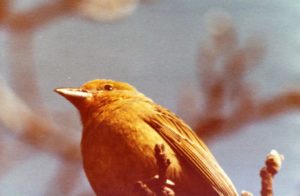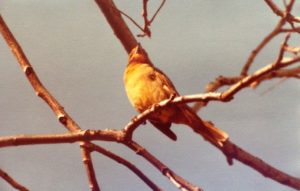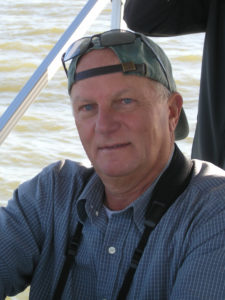A shorter version of this account was published in the Spring 1982 edition of the Illinois Audubon Bulletin.
Exotic birds? Unusual birds? Probably none so unusual ever crossed our path as the one that appeared in our midst on November 23, 1981.
“Hepatic,” it means “relating to the liver” or, in this case, liver-colored. Not a great start, but a great story…..
My parents, Loraine and Eunice Funk, were preparing to haul an animal or two from our dairy farm in Beverly, Illinois, to Schweigert’s at Tremont for the annual Illinois Invitational Jersey Sale. At the time we were milking about 80 cows, but a good portion of our income was from the sale of breeding stock, hence the trip to Tremont. The truck was all loaded (including cows, if I remember correctly) and parked in front of the garage. Uncle Bob, my younger brother, and I had been in the milkhouse, and as we exited, he asked, “What’s that bird in the hackberry?” Bob wasn’t really a birder, except by osmosis, being the son of my birding parents and my brother, but he noticed “something different.” I saw immediately that it was “something unusual” – larger than a House Sparrow, and mostly orange-yellow. After just a few seconds it flew around the west side of the old barn and landed in one of the evergreen trees on the north side of the barn lot.
I had no binoculars at the barn. What I did have was a .22 rifle with an 8x scope, so I grabbed it from the truck and viewed the bird (perhaps to his alarm…who knows?). A brief look told me it was likely a tanager (right size, shape, and bill type) and most likely a Summer Tanager, with no sign of black on the wings. The bird then flew a short distance to the magnolia tree next to the garage. I managed to dash inside the house and get my parents’ attention, and they saw the bird for just a few seconds before it flew away. I saw it again very briefly later in the day flying around a pile of gates near the solar barn. [The solar barn was a combination calf barn and hay barn with the south roof panels replaced with clear plastic, with a flat-black-painted insulated attic. The fan from the grain dryer pulled air across this attic, warming the air by 15-30 degrees F and allowed us to do most of our grain drying for several years without using propane. This was designed primarily by my brother, Dr. Ted Funk, retired Agricultural Engineering staff from the University of Illinois at Urbana – Champaign.]

That evening I called Dave Bohlen at the Illinois State Museum to report. When I told him I believed the bird to be a summer tanager, and gave a description, his response was, “Had you considered hepatic?” Uh, no. Why should I?” I had seen one Hepatic Tanager in my life, and that it was in southeast Arizona, one of the few places in the country where they “belong,” in April of 1971. No Hepatic Tanager had ever been reported east of the Mississippi River. Dave’s reasoning, however, was that since NO tanager should be in Illinois that late in the fall, one species was about as likely as another and none should be excluded. I began reading about Hepatic Tanagers in the Bent Life History Series and grew rather excited. The bird had NOT really looked like a Summer Tanager, and certainly not like a Scarlet, and it looked awfully “comfortable” in that evergreen (Hepatic Tanagers spend most of their time in evergreens in the mountain southwest.) One thing I noted in the literature was the “chuck” call note typical of the species.
The next morning at daybreak I was scouring the premises for the tanager. As I roamed the barnyard and house vicinity, I occasionally uttered what I presumed to be a reasonable imitation of the “chuck” call note. When something “chucked” back at me from under the apple tree on the west end of their garden I nearly had a heart attack! Sure enough, there was the tanager, eating a frozen apple from the tree (Jonathan variety) in the garden. We watched it through the telescope for a few minutes before running for the telephone. Dave’s reaction from Springfield was “I’ll be there in an hour. Put out some fruit!” I’m glad no one got in his way during the drive, because he didn’t take much longer than an hour to cover the 80 miles between Springfield and Beverly.

In addition to calling Dave, I’m pretty sure I called Pat Ward, Bob Randall and a couple of people from Quincy. The word spread from there. There’s no telling what a mob we would have had with today’s network!
The story of the rest of the week is well-done in my mother’s memoir, Grandma Married a Birder. She relates what it was like to fix Thanksgiving dinner surrounded by visiting birders, one of whom stayed for Thanksgiving dinner, and try to keep the coffee pot full and the cookie plate filled as between 80 and 90 individuals came from surrounding states. There were people waiting when we came home from church on Sunday, and some of them stayed for lunch.
I don’t think the neighbors were the least bit surprised by the commotion. Our reputation preceded us.
Many of the sightings were made at Granville Hill’s yard, about half a mile northeast of the Funk farm, as their apple tree had a bumper crop of frozen fruit, which I think were Golden Delicious. The best pictures, including the one on our wall at home, were taken at Hill’s. The bird made a brief appearance in our yard, allowing us to add it to the “yard list.”
Nearly everyone who came did eventually see the bird except one couple who were extraordinarily impatient, and of course those who didn’t come until the following Monday, as was not seen after Sunday when the weather turned bad; the bird either succumbed or decided it had had enough of Illinois and headed south.
Postscript
Birding in our family was a group project. My parents pretty much had us out every weekend during migration, plus we were “out” all the time when we were working. One of my younger sister Mary’s most memorable expeditions was when she was about 7, and we climbed a bluff in Calhoun County to see a Hooded Warbler. I carried her (she is 12 years my junior) a good portion of the way up the slope. Her comment was “I wish I was home in my own little bed!”
My grandkids live down the road, and they are the 8th generation on the property, but we no longer farm. One of the neighbors does the farming, and there has been no livestock since 2001.
Hepatic tanager has to be the best yard bird, but we also had Bewick’s Wrens nesting in our gas grill twice and our dryer vent once. Other than that there was nothing more exciting than a Pileated Woodpecker. I have no idea what my yard list was at my parents place, but I know it was not as impressive as the yard list we had when we lived a mile west of Beverly, where we had black and yellow Rail, among other interesting stuff.
My Illinois life list at the time was probably about 320. It’s at 345 now, but I haven’t done nearly as much chasing recently as I did in the 70s. I’ve birded all fifty states, including driving to Alaska and back this past summer. I’ve also been birding in western Canada, Costa Rica, Mexico, the Dominican Republic, and Trinidad and Tobago.
I’m still birding, and if I ever manage to retire, I hope to be more active!
By James L. Funk
Edited by Ted Wolff
Hepatic Tanager Recollections
How did word get out about this Illinois rarity in those antediluvian pre-internet days? I believe Jim Funk contacted Dave Bohlen to confirm identification, and Bohlen then reached out to Larry Balch, after which the word was spread among Chicago area birders. I have a dim recollection of talking to Dave Johnson about it during that period.
I left my home in Mt. Prospect in the wee hours of Thanksgiving day so that I could arrive at the Funks at first light. Leaving on Thanksgiving morning attests in some measure to how supportive my folks were, that they were fine for me to be gone most of the day but be back home by dinner.

I did see the tanager, and wound up staying for breakfast, which the Funks graciously offered. The most memorable moment of that meal was the discourse provided by one of the younger members of the family who said she wanted to marry a dairy farmer who raised Jerseys. I left and arrived home in plenty of time to enjoy Thanksgiving with my family. It was a most productive day.
Postscript
I have no idea what my Illinois life list was at the time, but having just lost Thayer’s Gull to the vagaries of taxonomic pronouncements my list plummeted to 399 where it currently stands. The recent Broad-billed Hummingbird and Magnificent Frigatebird would have been state birds, but they were not chaseable.
In my view the best three birds ever recorded in the state were the Large-billed Tern in 1949 (a first for North America), the Eleania (depending on which of the two species it would be either a first or second North American record), and the Common Ringed Plover (second Great Lakes record and first for Midwest). The last two mentioned are probably the best birds I have seen in Illinois.
By Joel Greenberg
Westmont, Illinois
The 1981 Thanksgiving Hepatic Tanager
It had been a normal Thanksgiving Day with extended family in the Chicago suburbs. I had planned to bird the Chicago lakefront the next day (Friday, November 27, 1981) with my friend, Homer Eshbaugh. Late on Thursday afternoon, Homer called to tell me that his plans had changed. He explained that a Hepatic Tanager had been discovered and confirmed “near Quincy” and that he was going to chase it in the morning with some other Chicago area birders. There was one seat left in the car. Did I want to come along?

I started birding seriously in 1977, and until this time had never chased a bird that was further than 90 minutes away, so I had to consider the idea for a few seconds. It took a few seconds more when he told me that they could pick me up at 0330 on Friday morning. Since I had never seen an Hepatic Tanager, I decided that I would go.
A car pulled into the driveway at 0330. Larry Balch was driving. It may have been the second time that I had met him. Homer was in the car, plus one additional birder who I think was Richard Biss. I got into the back seat and off we went. We arrived about 30 minutes after sunrise. Other birders were already present, so we didn’t have a problem finding the bird in an apple tree on the Funk farm. I got close-up looks through Larry’s and Homer’s Questars.
The Funk family was wonderfully cordial and welcoming. This was my first experience with guest books at bird rarity sightings. Some of us were given a tour of the buildings and the award-winning dairy herd of Jerseys. We stayed a little over 90 minutes visiting with the Funks and the other birders present.
Before we headed back to Chicago, I had a request: “Were there any Eurasian Tree Sparrows around?” I had never seen one. With a suggestion from Jim, it didn’t take long to find a flock of them, after which we headed back to Chicago. Larry, Homer and Rich were congratulating themselves on “sweeping the tanagers” in Illinois. I was pleased to have added 2 birds to my life list. The Eurasian Tree Sparrow followed Hepatic Tanager as life bird #358, and Illinois lifer #280.
My Illinois life list was at #396, but is now #395 with the Thayer’s Gull lump. The Hepatic Tanager is probably the most special Illinois bird for me because it was a life bird, my first long chase to see a bird, and because it remains Illinois’ only record of this species. However, finding the Garganey in Garden Prairie probably ties the tanager, as it’s always more rewarding to find and see a rarity.
by Dan Williams
Rockford, Illinois
